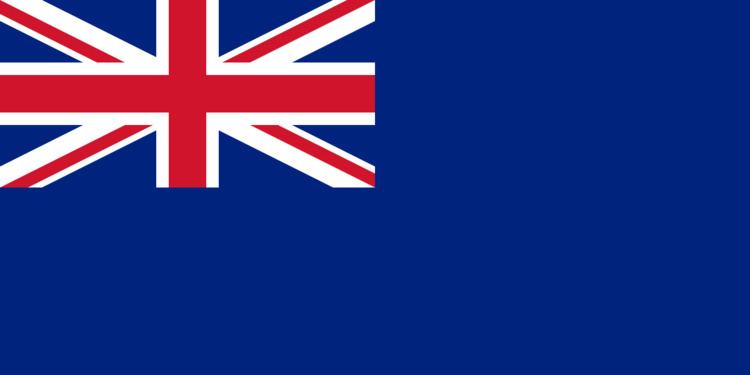Use State ensign | Proportion 1:2 | |
 | ||
The Blue Ensign is a flag, one of several British ensigns, used by certain organisations or territories associated with the United Kingdom. It is used either plain, or defaced with a badge or other emblem.
Contents
- Plain blue ensign
- Defaced blue ensign
- Flags of UK Overseas Territories using defaced blue ensigns
- National flags based on the Blue Ensign
- Other flags based on the Blue Ensign
- References
The evolution of the Blue Ensign followed that of the Union Jack. The ensign originated in the 17th century with the St George's cross (the Flag of England) in the canton, and with a blue field (top right).
The Acts of Union 1707 united England and Wales with Scotland in the Kingdom of Great Britain, thus producing a new Blue Ensign with the new Union Flag in the canton. With the Act of Union 1800, Ireland joined the United Kingdom and St Patrick's Cross was added to the Union Flag and, accordingly, to the cantons of all British ensigns from 1 January 1801.
Plain blue ensign
Prior to the reorganisation of the Royal Navy in 1864, the plain blue ensign had been the ensign of one of three squadrons of the Royal Navy, the Blue Squadron. This changed in 1864, when an order in council provided that the Red Ensign was allocated to merchantmen, the Blue Ensign was to be the flag of ships in public service or commanded by an officer in the Royal Naval Reserve, and the White Ensign was allocated to the Navy.
Thus, after 1864, the plain blue ensign (i.e., without any defacement or modification) is permitted to be worn, instead of the Red Ensign, by three categories of civilian vessel:
- British merchant vessels whose officers and crew include a certain number of retired Royal Navy personnel or Royal Navy reservists, or are commanded by an officer of the Royal Naval Reserve in possession of a Government warrant. The number and rank of such crew members required has varied over the years, as have the additional conditions required, since the system was first introduced in 1864.
- Royal Research Ships by warrant whether manned by former Royal Navy personnel or Merchant Navy personnel.
- British-registered Yachts belonging to members of the following yacht clubs:
Permission for yachts to wear the blue ensign (and other special yachting ensigns) was suspended during both World War I and World War II.
Defaced blue ensign
Since 1864, the Blue Ensign is defaced with a badge or emblem, to form the ensign of United Kingdom government departments or public bodies. Current defaced Blue Ensigns (besides yacht clubs listed below) are:
Yachting Blue Ensigns defaced by the badge of the club were recorded in the Navy List until 1985, and now they are administered by the Royal Yachting Association for the Ministry of Defence. Current defaced Blue Ensigns are:
Flags of UK Overseas Territories using defaced blue ensigns
Current flags:
Former flags: The defaced blue ensign was formerly used as:
National flags based on the Blue Ensign
These include:
